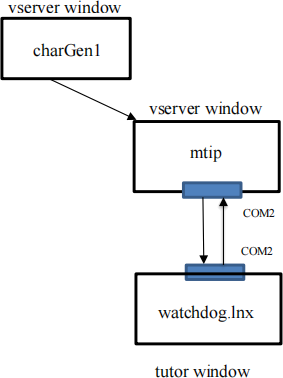CS 341 Computer Architecture and Organization
Hello, dear friend, you can consult us at any time if you have any questions, add WeChat: daixieit
|
Computer Architecture and Organization |
CS 341 – Fall 2021 |
Machine Project Assignment
|
|
|
mp5: Watchdog Timer
I. OBJECTIVES:
Embedded systems use a watch dog timer to recover from program malfunctions. During faulty software operations (e.g. a program gets stuck in an infinite loop), expiration of a watchdog timer causes the system to reboot. In embedded applications, these timers can be implemented in either software or hardware. This assignment teaches students on how to implement a watchdog timer in software. Copy files for this exercise from /courses/cs341/f21/cheungr/mp5/ to your cs341/mp5 directory. You will use timing functions provided in timepack_sapc.c.
II. Operations of a Watchdog timer:
One can imagine if an embedded system installed in a remote area goes haywire, it may be impossible or very costly to send a service personnel to reset the system. See an example application on theNASA Deep Space Probe![]() and a more recent one on theMars helicopter flight. A watchdog timer can automatically reset the system without human intervention in the event of a system failure.
and a more recent one on theMars helicopter flight. A watchdog timer can automatically reset the system without human intervention in the event of a system failure.
In theory, awatch dog timeris a timer that is set to expire at a pre-determined time interval. During a faulty condition (e.g. software is stuck in an infinite loop), timer expiry reboots the entire system. If the watchdog timer is implemented in external hardware, its logic will send a signal to the reset circuit (e.g. power up restart) ofthe embedded system when the timer expires. If implemented in software, the interrupt service routine ofthe timer will run a reboot function that restarts the application from scratch.
Since rebooting an application causes a major interruption to the operation of the system (similar to the powering up your computer), you don’t want to reboot it ifthis is not needed. In most cases, we don’t know exactly when the problem will occur, but we may have some estimate on the time when the problem will likely to occur. Then you set the watchdog timer to expire at or a little after that estimated time. For those times that the software is running without fault, you reset the watchdog timer before it expires to prevent interrupt from happening. This action is known as “kicking the dog”
III. Software implementation of a Watchdog timer:
a) Part 1: Simulating the coding problem:
We use a similar test set up as in mp4. The test program for this mp is charGen1.c and is provided in the cs341/mp5/ directory. scp the file to your vserver VM and build the charGen1 executable at the vserver VM using:![]()
gcc –o charGen1 charGen1.c
Build the software application watchdog.lnx in users.cs.umb.edu using the provided makefile, watchdog.c, reboot.s and timepack_sapc.c files. scp the watchdog.lnx to your vserver VM and load it into the tutor VM using mtip and ~d. Run the programs in this sequence:
i) Start the watchdog.lnx using tutor command: go 100100
ii) Open up a remote ssh window at vserver VM and run charGen1 to generate test characters to COM2 at 1 second intervals using:
sudo ./charGen1
(use cs444 as your sudo password)

The provided code in watchdog.c will print out characters received from the charGen1 driver. After 10 characters, the system will get stuck in a simulated infinite loop and no characters will be printed out. However, the serial port interrupts are ongoing. The program continues to execute the serial port ISR and process the received characters, but the main() is not printing them out.
Capture a run ofyour program in the tutor VM with a typescript file named script_part_1.
b) Part 2a: Reset the system using a watchdog timer
Code the watchdog timer using functions provided in timepac_sapc.c. Set the count value = 0 to generate an interrupt every 55mse (this is longest duration between interrupts you can set with a 16-bit counter hardware). When the watch dog timer expires, the ISR calls a reboot function (the provided reboot.s) that restarts the watchdog.lnx program. If you want to wait a longer time to do reboot(), you have to modify the ISR software as follows:
void irq0inthandc()
{
….
tickcount++;
if (tickcount %300 = = 0) reboot(); // this will do reboot every 300* 55ms
…
}
Cat your programs (watchdog.c, timepack_sapc.c and reboot.s) and capture the run ofyour program in the tutor VM with a typescript file named script_part_2a.
c) Part 2b: Implement the “Kick the dog” function
At the end of the do_work() function, implement a kick_dog() to call the set_timer_count function to reset the count back to 0. This will prevent the timer from expiring under normal circumstances. If the program gets stuck in the middle of do_work() and kick_dog() is not run, then the timer will expire and the program will get rebooted at the timer ISR.
Cat your programs (watchdog.c, timepack_sapc.c and reboot.s) and capture the run ofyour program in the tutor VM in a typescript file named script_part_2b.
Any private functions or variables you need should be declared static in "timepack_sapc.c", so that the calling program can never accidentally use a variable or function with the same name, or interfere with yours.
FINAL NOTE:
Leave working versions of the source files and the script files in your mp5 project directory. The grader or I may rebuild them and/or run them to test them. A copy oftherubric sheetfor grading mp5 is included. In the event that you are unable to correctly complete this assignment by the due date, do not remove the work you were able to accomplish - partial credit is always better than none.
2021-12-14